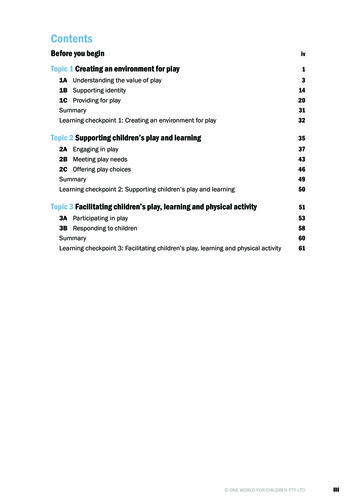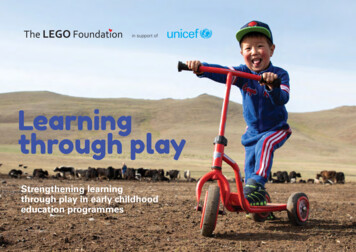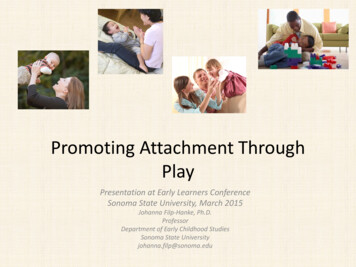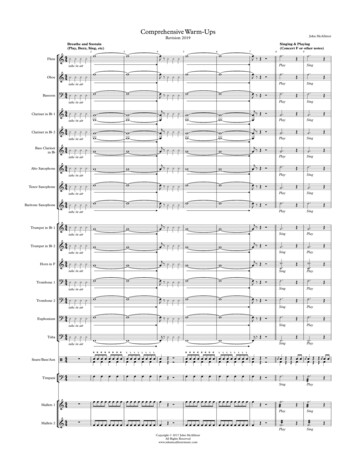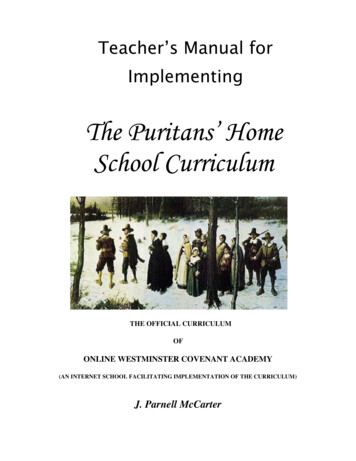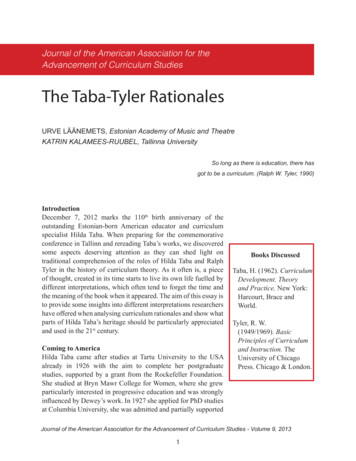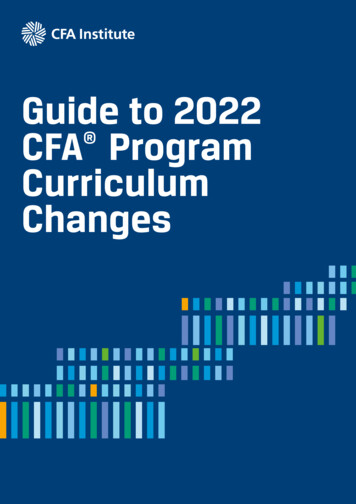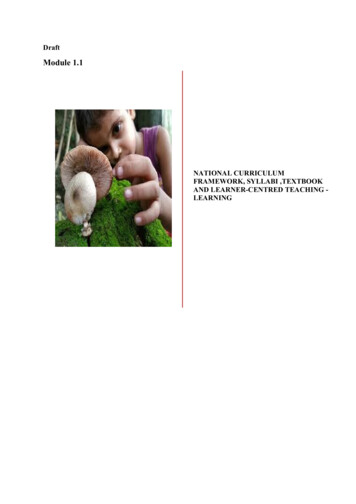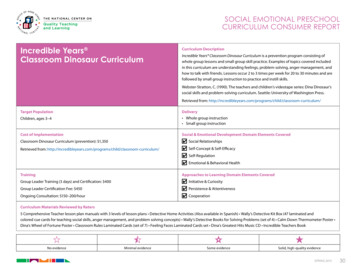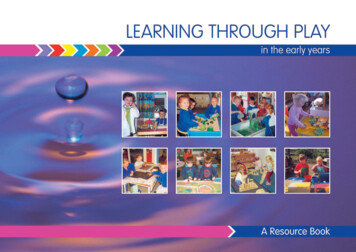
Transcription
LEARNING THROUGH PLAYin the early years
LEARNING THROUGH PLAY – INTRODUCTIONCONTENTSIntroduction4Learning Through Dramatic Play11Learning Through Sand Play25Learning Through Water Play55Learning Through Dough and Clay Play81Learning Through Table Top Play93Learning Through Small World Play105Learning Through Construction Play123Learning Through Creative Play1533
LEARNING THROUGH PLAY – INTRODUCTIONThis booklet has been compiled by the Early Years Interboard panel in response to requests bypractitioners in Early Years settings for guidelines on provision and progression in play.The methodology and suggested progression in this document is appropriate for the proposedFoundation Stage as recommended by CCEA.It is proposed that teachers will use this resource as a starting point for their own planning.We hope you find it useful.Early Years Interboard PanelDawn CrosbyUna CrosseyLiz CroweClare Devlin4SEELBNEELBBELBSELBNuala HeaneyWELBAnne McDermott SEELBMarilyn WarrenBELB
LEARNING THROUGH PLAY – INTRODUCTIONACKNOWLEDGEMENTSThis resource was designed and compiled by members of the Early Years Interboard Panel. We are particularly grateful tothe following teachers for their contribution:Doreen O’Neill– St Joseph’s Nursery Unit SELBLornette McAlister – Abercorn Primary School SELBPatricia Dunne – St. Eithne’s Primary School WELBHazel Harris – Gracehill Primary School NEELBWe would like to thank the Assistant Senior Education Officers of the five Education and Library Boards for theirencouragement and for their financial support.The Interboard Panel is also grateful to officers at CCEA for their technical support in the design and production of the file.Thank you also to those schools who allowed us to include photographs of play sessions:Ballymoney N.S., Black Mountain P.S., Bligh’s Lane N.S., Downpatrick N.S, Dunclug N.S., Glenwood P.S., Kylemore N.S.,Magherafelt N.S., Omagh County P.S., St. John the Baptist N.S. and Trinity N.S. Bangor.Finally, a special word of thanks to Lorraine Noble (SEELB) for her endless patience and her faultless word-processing skills.5
LEARNING THROUGH PLAY – INTRODUCTIONA RATIONALE FOR PLAYOur thinking about play has been influenced over the years by the work of many educationalists,psychologists, researchers and practitioners, and much has been written about how youngchildren learn and how adults can support this learning.In the opening chapter of her book “Early Childhood Education”, Tina Bruce traces this history ofresearch from Rousseau and Kant in the 18th century, the 19th century practitioners like Froebel,Montessori and Steiner, and on through to 20th century thinkers like Piaget, Vygotsky and Bruner.At this point in time our knowledge base is being challenged further by the work of HowardGardner, Ferre Laevers, Loris Malaguzzi, Chris Athey and others.What has emerged from all of this thinking is a set of common principles to which all early yearspractitioners can sign up.6
LEARNING THROUGH PLAY – INTRODUCTION10 COMMON PRINCIPLES OF EARLY YEARS EDUCATION1.The best way to prepare children for their adult life is to givethem what they need as children6.There are times when children are especially able to learnparticular things.2.Children are whole people who have feelings, ideas andrelationships with others, and who need to be physically,mentally, morally and spiritually healthy.7.What children can do (rather that what they cannot do) is thestarting point of a child’s education.8.3.Subjects such as mathematics and art cannot be separated;young children learn in an integrated way and not in neat,tidy compartments.Imagination, creativity and all kinds of symbolic behaviour(reading, writing, drawing, dancing, music, mathematicalnumbers, algebra, role play and talking) develop and emergewhen conditions are favourable.4.Children learn best when they are given appropriateresponsibility, allowed to make errors, decisions and choices,and respected as autonomous learners.9.Relationships with other people (both adults and children) areof central importance in a child’s life.5.Self-discipline is emphasised. Indeed, this is the only kind ofdiscipline worth having. Reward systems are very short-termand do not work in the long-term. Children need their effortsto be valued.10. Quality education is about three things: the child, the contextin which learning takes place, and the knowledge andunderstanding which the child develops and learns.Tina BruceThese principles underpin our Early Years curriculum and guide our planning. Well-planned andwell-resourced play activities which allow for progression in a child’s thinking and understanding canprovide the context in which these principles become the reality for all our children.7
LEARNING THROUGH PLAY – INTRODUCTIONWHAT IS PROGRESSION?Progression in play reflects the observation and assessment of children’s knowledge, skills andattitudes in order to provide developmentally appropriate experiences. Children come topre-school already as skilled learners. Through our observations, assessment and professionaljudgement we gain valuable insights into how each one learns best. This information informs ourplanning to meet the needs of each individual child. Progression in play comes about as a resultof a real understanding of the interests, needs and experiences of the child.As practitioners, we need to understand that there must be a progression in the provision ofactivities to meet the developmental needs of children.8
LEARNING THROUGH PLAY – INTRODUCTIONTHERE ARE 2 STRANDS OF PROGRESSION WHICHIMPACT ON EACH OTHERStrand 1Strand 2Progression in LearningProgression in Provision(knowledge & understanding, skills and attitudes)(extending experiences and resources; the adult’s role)Experimental Play Child says “What is this?”Child plays aloneChild plays with little organisationChild moves material or equipment from one area to another orspreads over floor indiscriminatelyChild builds up and knocks down e.g. construction materialChild explores properties of materials e.g. stacking, balancing,rolling, pouring, filling, pushing, pullingChild displays little or no language or conversation related tomaterials or equipmentThere are two important aspects to extending quality play.–– extending the provisionthe nature of the adults’ role e.g. interacting, facilitatingChildren need help to extend their play. Adults can contribute to thedevelopment of abstract thinking, for example, by adding resourcesand props, by asking open-ended questions and posing excitingchallenges.Making and Doing Child says “What does this do?”Child builds recognisable structures with a purpose which aremeaningful to them e.g. series of towers, bridges, horizontal andvertical structures (names given to structures)Parallel play is evidentChild begins to solve problems of balance, shape, distanceConversation relating to material developing among the children9
LEARNING THROUGH PLAY – INTRODUCTION10Strand 1Strand 2Progression in LearningProgression in Provision(knowledge & understanding , skills and attitudes)(extending experiences and resources; the adults’ role)Imagining and ThinkingThe Role of the Adults Child says “What can I/we do with this?” Child involved in group planning and organisationThe adults will facilitate the progression in learning by planningappropriate activities. Child builds more complicated structures e.g. roof and windows Child uses props, signs, labels Child uses a variety of resources in an imaginative way Interest is often maintained for several daysThey will: Support children in their play Provide good quality resources Be aware of the potential learning in all areas of the curriculum Model skills involved in play Interact with the children, asking questions and making suggestionsto support their learning Be familiar with key vocabulary – model and support children intheir use of key words Work alongside children, modelling skills and attitudes Read with children from fiction/non-fiction books, plans, instructioncards etc. Scribe children’s ideas and thoughts, and display their work Observe children’s learning and use of the provision Assess children’s development/progress to inform planning forfuture learning
LEARNING THROUGH DRAMATIC PLAYin the early years
LEARNING THROUGH DRAMATIC PLAYDRAMATIC PLAYDramatic Play gives children the opportunity to Express themselves Explore language freely Explore feelings and find out about themselves and others Develop co-operation, care, consideration and control Exercise choice and make decisions Use mathematical language and develop mathematical concepts Develop a range of motor skills Use their skills to make the things needed for their play and adapt as necessary Explore a fantasy world of their own creation13
LEARNING THROUGH DRAMATIC PLAYTHE DEVELOPMENT OF DRAMATIC PLAYIt used to be thought that children’s dramatic play developed through similar stages to that of other forms ofplay: Onlooker Solitary Parallel Co-operativeIt has been shown that each of these types of play is evident at each stage of development and at somestages more of a particular style will dominate.Children imitate the people around them by recreating scenes from everyday life and acting out familiarroles. From this, imaginative play develops as they develop the ability to incorporate narrative into their play.As they grow, their ability to imagine exerts greater influence on the nature of their play. Their play becomesincreasingly complex and the narratives which are created include more characters and episodes.The imaginary world children create enables them to realize in their imagination the things that cannot berealized in reality. Fantasy play contributes to children’s creativity and imagination and should beencouraged.Adapted from ‘Supporting Creativity and Imagination in the Early Years’ by Bernadette Duffy14
LEARNING THROUGH DRAMATIC PLAYRELEVANT LANGUAGE DEVELOPMENTLanguage development runs through all dramatic play activities. Talking and listening skillsdeveloped through dramatic play form the narratives which are the basis of reading and writing.Opportunities to develop reading and writing occur within meaningful contexts in a role playarea.In role play situations children can experiment with thelanguage they have acquired as well as new vocabularythey are introduced to in school.Specific vocabulary and use of language is dependent onthe type of imaginative play offered to the children.15
LEARNING THROUGH DRAMATIC PLAYRESOURCESHome CornerKITCHENkitchen furniture e.g. sink, cooker, cupboard, table,chairs, fridge, microwave, dishwasher, rubber gloves,cups, saucers, cutlery, pots, spice rack, vacuumcleaner, pans, cooking/baking utensils, timer, clock,ice-cube tray, vases, tablecloth, towels, cloths, ironand ironing board, rubber gloves, dusters, brush anddustpan, broom, kettle, apron, toaster, variety ofcontainers, shopping basket, bags, lunch boxes, realfood or play materials representing food, noticeboard, writing implements, recipe books, shoppinglist, first aid kit, hot water bottle, flowers, postcards16LIVING ROOMsofachairT.V.videomagazine dogtelephone and directoriesplantsT.V.guidesbooksmirrortelephone and address bookcataloguesfamily photos, puppets (for use with TV)BEDROOMbedscotsbed clothesdollssets of dolls’ clothesall purpose clothing with velcro fasteningshatslengths of materialcloakshangersdressing tablemirrorjewelleryhandbagsshoesvariety of scarves
LEARNING THROUGH DRAMATIC PLAYRESOURCESRESTAURANT/CAFÉ TAKE-AWAYname of cafésigns within café –opening timestablechairtable clothkitchen cooking equipmentcups, plates, cutlerystrawsflowersrecipe bookscash registerpictures of foodfood – made of dough, foam, commercially producedfoodboard for dish of the dayorder pads –pens/pencilsnapkinsplace matsmenumoneycarrier bagsphoneFLOWER SHOPflowers – made by children using paper, card,cellophane, found materialsshop signs – opening timesdried flowerscommercially produced flowers – paper, silk,plasticreal flowers and plantsoasisshopping basketscataloguescash register, moneyprice liststelephoneorder bookcards – large, small, message cardswrapping paperpostersbucketsplastic vasesplant sprayersflower potsribbonspressed flowersPOST OFFICEpost boxpost office uniformsignsleaflets and forms – tax, passport, TV licenceenvelopes, paper, penscardsstampslabelswrapping paperparcels of various sizes, weights,scalestelephonestampers and stamp padtill and moneysavings booksforeign currency, stampsmailbagmaps17
LEARNING THROUGH DRAMATIC PLAYRESOURCESHOSPITAL/HEALTH CENTREdoctor/nurse uniformambulance driver’s uniform/ambulancedoctor’s bag/rubber glovesdollsbeds/bedclothesbandages/cotton woolplastersmedicine bottles, spoonssyringesstethoscopesthermometersold X-ray picturesold plaster castscrutchesscalesheight measureswaiting areatelephonenote pad/prescriptionsclipboard, get well cardsreference books about the bodyposters/chartsappointment bookfiles18TRAVEL AGENTS/HOLIDAYSdesktelephoneholiday posters, destinations, planes, packssummer clothes/winter clothessunglassesbuckets, spades, sunhats, rubber rings, beachball, goggles, fishing netpicnic rug and equipmentGARDEN CENTREseeds, seed packets for flowers, vegetables, fruitbulbsherbsseed trayslolly sticksflower potsvariety of flowers/plants, paper, silk, plastic, made bythe childrenfoliagetools – trowels, forks, spades, rakeswatering cans, water spraylawn mowersoil, compost, grow bagsbird tablewater featurelogsgarden furniturecounter, till, money, phonegardening magazines and cataloguesstory and reference books re. gardening, growing
LEARNING THROUGH DRAMATIC PLAYDRAMATIC PLAYPersonal, Social & Emotional DevelopmentCreative/Aesthetic Development co-operate, take turns and initiate role-playdevelop confidence, self-esteem, self-control in re-enacting real life situationslearn how to work independently and access the resources they needlearn how to work as part of a group e.g. taking on different roles in a groupsuch as shopkeeper and customerexpress individuality and own personality through imaginative playuse language of social interactionlearn to have respect for others’ ideas and accommodate these in role playhelp to tidy up at the end of the sessionshow initiative when developing ideas in the role play area e.g. deciding tomake signs for the shopreflect on feelings as part of role play e.g. hospitaluse role play to act out their own joys, concernsPhysical Development develop fine motor skills and co-ordination through manipulating real toolssuch as whisks, telephones, key boardsdevelop co-ordination through fastenings on clothes, pouring tea from tea potssetting table, dressing dollsdevelop awareness of space available in role-play area and how to share thatspace with others use imagination to develop ‘stories’ in the role play areaintroduce the language of colour and texture through the use of, andintroduction of different types of materialencourage children to create and design their own menus, diaries, pictures,price lists, posters, leaflets, cardsmake items for role-play e.g. playdough, buns, cakes, biscuits for shop, junkmaterials for sandwiches, burgers, meals for cafeKnowledge and Appreciation of theEnvironment create role-play areas based on knowledge about their local environment,homes and cultures e.g. supermarket, library, chemist, farm house, seaside,hospital, clinic, doctors surgery, nursery schooltalk about their families in relation to events in role-playre-enact special occasions e.g. wedding, birthday party, Christmasrelate the work of people in the local community to role play e.g. visit to the firestation, farm, building site, post office19
LEARNING THROUGH DRAMATIC PLAYDRAMATIC PLAYEarly Experiences in Science & TechnologyLanguage Development explore and recognise features of living things e.g. through hospital, vets,garden centre role-playexplore and recognise feature of how things work through garage, toy shoprole-playexplore and select materials and equipment appropriate to the role-playdevelop scientific skills, knowledge and concepts through role-play – topics mayinclude babies, holes, wheelsuse technology e.g. a shopping till, calculatorselect appropriate materials to make models e.g. wheeled vehicles, prams,furniture etc., for use in role-play areadevelop skills of cutting, folding, joining talk about what different people do in role-play situationstalk in the language of different roles e.g. shopkeeper, mummy, Little Red RidingHoodrole-play nursery rhymes, storiesuse language to plan and create real-life or imaginary situationsdevelop the language of dialogue e.g. listen to and respond to what otherchildren/adults sayextend vocabulary associated with imaginary/role-play e.g. hospital, airport,artists studio, garden centrehave access to related books fact/fiction in role-play areadevelop writing skills e.g. writing shopping lists, prescriptions, Get Well cards,record sheets, forms, bills, leaflets, menus, lettersdevelop ICT skills through office role-play – telephones, keyboards, photocopier,computerEarly Mathematical Experiences 20explore various mathematical concepts related to money, capacity, size, weight,one-to-one correspondenceuse language related to all of the above e.g. how much, full, empty, needmore/less, heavy, lightproblem solve through imaginative play e.g. how much money will I need forthis item? How many cups will I need for the family?develop concept of time in house play – breakfast, dinner, bed-time, time indoctors surgery. Refer to clocks, watchesorder, sort, match in role-play area
LEARNING THROUGH DRAMATIC PLAYDRAMATIC PLAYImitative play – to be able to play in a familiar environmentand adopt a role that reflects own experiencee.g. mummy, daddy, boy, girl, babyExperimental PlayPOSSIBLEEXPERIENCESINTENDEDOUTCOMESACTIVITIES social interaction– build relationships– co-operation– take turns, join in– share basic home play provision. tidy up and care for equipment sensitive intervention of adultin role play, providing a rolemodel for actions andlanguage development make choices and decisionsdevelop curiosity develop language – usingfamiliar and newly introducedvocabulary develop communication andnegotiation skills express emotions and feelings add new equipment graduallyon a theme e.g. babies,cleaning, pets. encourage children reluctantto get involvedPROGRESSION basic home corner – kitchen,dressing up clothes kitchen utensils introduce real food, food fromdifferent cultures introduce familiar scenarios inhome corner – birthday, baby’sbath, new pet, ChristmasPROVISION cooking utensils, pots, pans,crockery, kettle, toaster, teapot,tablecloth, empty foodcontainers, dough cleaning equipment – rubbergloves, dusters, dustpan andbrush, mop, empty carton ofwashing powder dressing up clothes, phones,mirrors, posters, recipe books,notebook, pencils, pens, dollsprams, baby bottles, babyfood, baby clothes children may provideappropriate materials fromhome e.g. party hats,decorations develop manipulative skillsusing small equipment21
LEARNING THROUGH DRAMATIC PLAYDRAMATIC PLAYPOSSIBLEEXPERIENCESINTENDEDOUTCOMES recall own experienceExploring roles and feelings develop mathematicalconcepts in a meaningfulcontext – estimating, counting,measuring22 demonstrate literacy skills in ameaningful situation develop interest in cookingfrom home playACTIVITIESPROGRESSION shop play – grocery, baker,post office, flower shop gradually introduce moreprops to develop shop play mathematical conceptsmoney, exchanging, shapeand size, weight, comparison provide opportunities forreading and writing in eachrole play area hospital play, GP surgery, babyclinic café/take away develop hospital play byadding resourcesPROVISION refer to pages 16, 17 and 18
LEARNING THROUGH DRAMATIC PLAYDRAMATIC PLAYTo be able to choose/make appropriate props for role playUse pretend props and develop ability for symbolic playPOSSIBLEEXPERIENCESINTENDEDOUTCOMES develop mathematicallanguage and concepts develop literacy concepts andskills develop manipulative skills inconstruction of propsACTIVITIESPROGRESSION make props for dressing up –hats, food for shop, flowers forflower shop, sweets for sweetshop extend home corner by addingliving room, bedroom develop role play areas byencouraging children toprovide and make own propsPROVISION puppets for TV books, magazines dressing table, make-up,jewellery, scarves, belts, hats, child-sized bed, cot, baby’sclothes, pyjamas, dressinggown23
LEARNING THROUGH DRAMATIC PLAYDRAMATIC PLAYTo be able to act in role from a wider experienceand as a range of charactersPOSSIBLEEXPERIENCES24INTENDEDOUTCOMES project themselves intofeelings, actions of others e.g.fantasy characters from TV,fairy and folk tales – usingother cultures and traditions,their own time and other times start to introduce a story line ornarrative into play take on a role in an imaginarysituation e.g. princess, king,witches make-believe play – resolvedisagreements, create a story, explore a fantasy world solve problems create props and resourcesACTIVITIES addition of themed materialsto develop fantasy playPROGRESSION shopping activities café/restaurant play adults support children inacting out fantasy play –increasing the complexity ofthe narratives use language appropriate tospecific roles e.g. doctors,nurses, waiters, customers take on a role with rules thatgovern it e.g. as a vet, pilot,fireman, secretaryPROVISION Refer to pages 16, 17 and 18
LEARNING THROUGH SAND PLAYin the early years
LEARNING THROUGH SAND PLAYSmall children seem to be instinctively attracted to allthe things the planet is made of, and above all to sandand water. These materials offer rich learningopportunities for children but the learning would nottake place without the children’s own delight in thesubstances themselves – it is pleasure which providesthe motivation for their play.Children learn about the world through their senses and theirfirst response to sand and water is a sensuous one: they touch,pat, swirl, smell and stroke it, sometimes for very long periods,taking pleasure just in the tactile experience.Pre-School Learning Alliance27
LEARNING THROUGH SAND PLAYSOME RELEVANT LANGUAGEnamesof containersas much/many/fewtoo much/many/fewhow tsidebetweenleft derpartstays the sameroom to sparewholehow holdliftmoveoverflowpilepour in/outpullfallen downfullhalf-fullfit back in fit over
LEARNING THROUGH SAND PLAYSOME RELEVANT LANGUAGEall sdisappearsfalls infills upflattens outleaves behindlevels offmoves aboutpiles idsquelchyticklywavysinks insmooths outstays outstays the sametricklesall thedescriptiveand fantasylanguage thatchildren fallfeelfillgrindmakepick estickstirtilttiptrickle29
LEARNING THROUGH SAND PLAYSAND PLAYEquipment and Resources 30large sand traysmaller individual trayscreative sand traysilver sand, beach sand, builders’ sand(clean), Delta Sand (Hope Education)coloured sandsapronsbrushdustpanbucketsspades/spoonsclear plastic containers of variousshapes and sizestubingsieveswatering canjugscups plastic bottlesmouldscuttersplastic cutlerymodelling toolsrakescombsplant potsscoopsfunnelslollipop sticksegg timercreative sand traycreative sand accessories(NES Arnold)sand wheelssand mills
LEARNING THROUGH SAND PLAYSAND PLAYImaginative Duplolego construction kitsplay stractorsdumper trucksdinosaursflagsplastic flowerstea set‘treasure’natural materials conesjunk materials for building andmakingspecific resources associatedwith a topic or storypebblestwigsfeathersshellsconkersbun traysbaking equipmentmirrorsboatskitchen roll tubessmall world figurespalm trees31
LEARNING THROUGH SAND PLAYSAND PLAYMark making and pattern 32stickscombsrakespotato masherscutterscoloured sandpaperpeaslentilsricepastasawdustmodelling toolskeyssalt containerscreative sand tray and accessories
LEARNING THROUGH SAND PLAYSAND PLAYCapacity and Weight bucketscartonsladlesfunnelsspoonsegg cupsplastic cupsbalancesets of graded polythene bottlestake-away traysblocksshellssugar bagsplastic bagsflour bagscustard powder tins33
LEARNING THROUGH SAND PLAYSAND PLAYSubstitutesLentils/Grain/RiceIn a sense, there is no substitute for the joy of playing withthis natural material because of the strong appeal to veryyoung children. The potential for endlessly being destroyedand recreated makes sand play very therapeutic. There areoccasions when an alternative provides the stimulus ofchange.This cannot be used with childrenwho are sufficiently young orimmature to put them in theirmouths, ears or nose – Theirsmooth slippery surfaces makethem ‘pour’ almost like water.PeatPastaKept moist it can be pushed, transported and moulded intolandscapes as much the same way as sand, and it extendsthe garden theme.Different shapes colours and sizes. Excellent for scoopingand filling.SaltSawdust/ShavingsNeeds to be sieved to remove sharp splintersand should be kept damp so no dust is inhaled.N.B. Wood resin can make eczema flare up, soadults and children with allergies should takecare.34Careful of cuts!
LEARNING THROUGH SAND PLAYAdditional accessories can be added to the sandto provide the stimulus of change–accessories made from the same materials eg. wood, plastic, card, stainless-steel,–accessories which are the same colour or transparent or shiny–accessories which are the same but different sizes, e.g. buckets, spades, spoons, dishes, rakes, yogurtpots, plant pots–specific number of items e.g. 2 of everything35
LEARNING THROUGH SAND PLAYOUTDOOR SAND PLAYThe outdoor sand area facilitates learning in each curriculararea. The same provision and activities can be providedas for indoor sand play with the addition of largeritems for digging, filling, emptying, moving,pattern making and imaginative play. Theprovision of a pulley system for movingsand adds another dimension. Youngchildren love the freedom to getinto the sand pit, to exploreand experiment. A suitablecover needs to beprovided forhealth andsafetypurposes.36
LEARNING THROUGH SAND PLAYSAND (Wet/Dry)Personal, Social & Emotional DevelopmentCreative/Aesthetic Development learn how to work independently and select equipmentco-operate, take turns and share equipment as part of a grouplearn to respect others’ ideasextend imagination when developing ideas in the sand e.g. using the playpeople to make up a story in the sand, adding natural materialslearn to use the sand safely and with consideration for otherstalk about what they have done in the sand with confidence and a sense ofachievementdevelop self esteem by seeing displays of learning in the sandexperience the therapeutic value of working with wet/dry sandPhysical Development develop fine motor skills through manipulating tools, pouring, filling, stirring,pushing, pulling, digging, patting, moulding, drawing etc.develop hand/eye co-ordination e.g. pouring sand into containers, makingsand shapes using mouldsuse a range of equipment with increasing skill e.g. balance, sand wheel, sievesbe aware of the space in the sand tray and be able to share it with othersexplore 3D forms using a range of mouldsexplore shapes and textures associated with wet/dry sandexperience different colours and textures of wet/dry sanduse sand for line drawing and pattern makingcreate and explore sound using shakers of sand, gravel, pastaKnowledge and Appreciation of theEnvironment talk about their local environment eg. beach, building siterelate feature of their play environment to features of their own environmentwith the addition of suitable resourcesmake physical features such as hills, tunnels, roadschange the sensory nature of sand e.g. add pasta, change dry to wet/very wetsand37
LEARNING THROUGH SAND PLAYSAND (Wet/Dry)Early Experiences in Science & TechnologyLanguage Development explore the properties of dry/wet sand – comparelook at similarities, differences, patterns in dry/wet sanduse their senses to observe changes in sand e.g. adding water to drysandselect appropriate equipment for different types of sand playuse building skills Early Mathematical Experiences 38explore various mathematical concepts e.g. capacity, size, weightunderstand and use mathematical language e.g. full, empty, needmore/less, heavy, light, straight/curved lines, names of common shapesmake shapes and patterns in the sandsolve problems associated with sand e.g. how much will a specificcontainer hold? Pouring dry sand into a variety of different sizes ofcontainersdescribe the properties of sand e.g. rough, smooth, sticky, wetextend vocabulary associated with sand play e.g. pour, fill, empty, full,soft, bucket, sand wheel, sieve, mould dig, tunnel, rake, smooth, namesof sand toysdescribe their actions and the actions of others e.g. pushing, pulling,scoopingask and answer questionsrecall and report back at group timesdevelop pre-writing skills e.g. making patterns, marksmake up stories using additional props such as play people, farmanimals, vehiclestalk about their experiences in the sand from displays of photographs orbooks about sand playh
order book cards - large, small, message cards wrapping paper posters buckets plastic vases plant sprayers flower pots ribbons pressed flowers post box post office uniform signs leaflets and forms - tax, passport, TV licence envelopes, paper, pens cards stamps labels wrapping paper parcels of various sizes, weights, scales telephone .
